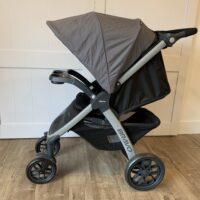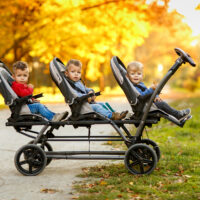Even with the various choices of safety car seats on the market today, car accidents still kill more children under the age of thirteen than any other cause of death. Since 2002, the LATCH system has attempt to make installing car seats easier and simpler. Instead of using the seat belt, LATCH secures the car seat directly to the vehicle via the tether anchor bars.
What is the LATCH system?
To prevent the growing number of infant and child deaths associated with car accidents, the British-German merger company Britax-Römer designed ISOFIX in the 1990s. In a joint project with vehicle manufacturers, this new system included designing car seats with hooked tether straps that attached to metal anchors in vehicles. ISOFIX was the first design of what would become the LATCH system in the United States.
LATCH – short for Lower Anchors and Tethers for Children – eventually spread to the U.S. Every vehicle and car seat manufactured after September 1, 2002, comes equipped with the LATCH system. Its unique tether and anchor design allows for a secure installation, but you can still use a seat belt when fastening the car seat in place. The LATCH system aims to make car seats easier to install with the goal of more car seats being installed correctly.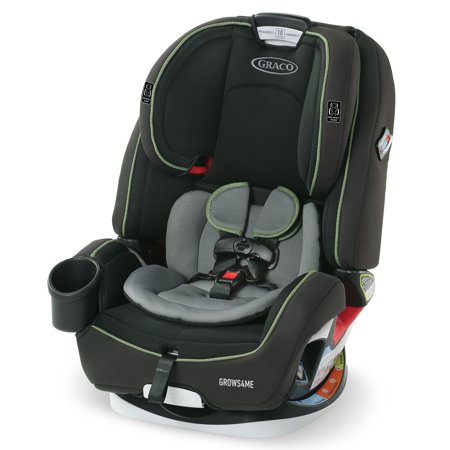
The GRACO Grows 4 Me – a 4-in-1 convertible car seat. All GRACO car seats come with the LATCH system for safer, easier installation.
Car Seat LATCH System: Tethers and Anchors
Both rear-facing and forward-facing car seats come with the LATCH system design. Vehicles with LATCH system requirements will have at least two places where you can install your car seat.
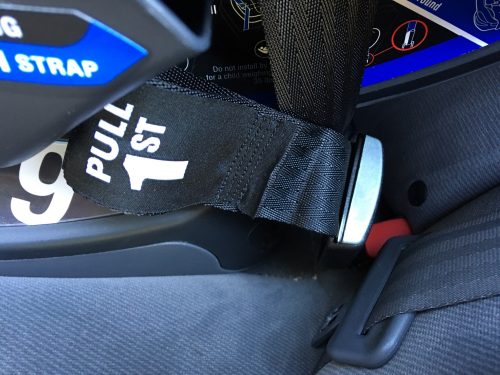
On your car seat, you will have:
- Two tethers with hooks (one of each side of the seat base)
- One top tether with a hook (on forward-facing and convertible car seats only)
In your vehicle, you will have:
- At least two metal lower anchors attached to the seats (located where the back and the seat meet)
- Anchors for the top tether (aka the tether anchor)
LATCH Tether
On the base of your child’s car seat, you will see two lower tethers that look like belts: one on the right and one on the left. The tethers have hooks attached to the ends. These car seat latch hooks attach to the metal anchors found in the seat of your vehicle.
In forward-facing and combination car seats, there is a third tether on the back of the car seat. This strap has a hook on the end that attaches to the tether anchor in your vehicle. Convertible car seats may require using both the lower tethers and the back tether, or they will instruct you to secure the seat using one or the other. This depends on the design of the car seat; the instructions will guide you on which tethers to use when securing your car seat.
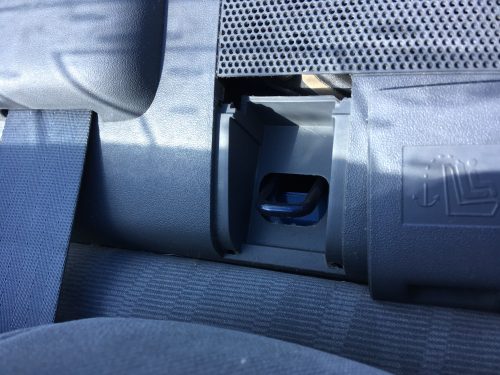
LATCH Anchor
There are two types of anchors in your car: lower anchors and tether anchors. The tether hooks connect to these metal bars. This completes the secure installation of the car seat without using a seat belt.
The lower anchors are located between the seat and the back. Depending on your make and model, these anchors stick out from between the cushions. However, in some vehicles, the lower anchors are hidden; indicators show their location so you can easily find them.
Most vehicles will have three top tether anchors in various locations. Unlike the lower anchors, the locations of these anchors vary. Depending on your make and model, the top tether anchors could be under the seat, on the rear window shelf, or the floor. Manufacturers strategically placed these metal bars for attaching the top tether hook on forward-facing and convertible car seats.
Car Seat LATCH System vs. Belt
As a result of the LATCH system, vehicle travel has become much safer for children. The National Highway Traffic Safety Administration recorded that car seats saved 325 infants and toddlers involved in car accidents in 2017. The LATCH tethers adjust and tighten once they are hooked to the metal anchors in your car. This makes sure the car seat and its headrest are in the most secure position, with limited to no movement in either direction during accidents.
Although the LATCH system is a simpler and easier installation technique than using a seat belt, it isn’t a fail-safe. About 3 out of 4 adults don’t know how to install their child’s car seat correctly. Parents and caretakers need to know exactly what the LATCH system is, what it does, and how it works – so that they can install their little one’s car seats correctly every time. It is estimated that when the LATCH system is used correctly, the amount of car seats improperly installed decreases by 50%.
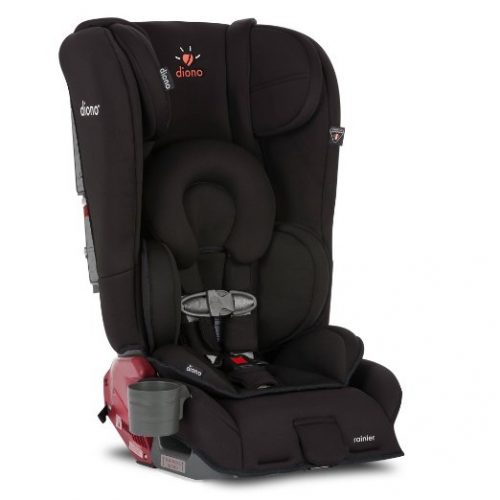
How to Install a Car Seat with LATCH System
The LATCH system is designed to be much easier than securing your car seat with a seat belt. Since the locations of the tether anchors vary, locate these before attempting your installation. Always consult both your car seat’s instruction manual and the user manual for your vehicle before securing your car seat.
This video from Penn State Health provides an excellent explanation of the LATCH system and how to install your LATCH-equipped car seat correctly.
No matter your make or model, there are some general steps to follow when installing your LATCH-equipped car seat:
- Locate the lower anchors and the top tether anchor that you will use to secure your car seat
- Connect the hooks at the end of the lower tethers to the lower anchors located in the seat of your vehicle
- Using your weight to press the car seat back against the seat, pull/adjust the straps to ensure a tight fit
- If you have a forward-facing car seat or a convertible car seat (in forward-facing mode), attach the top tether hook to the desired anchor in your vehicle. Pull/adjust the strap to ensure a tight fit against the top of the seat
- After you have installed the car seat, check your work. With your nondominant hand and the strength of a handshake, test for tightness by pulling the car seat front to back and from side to side at the belt path. The seat should not more more than an inch. If it does, continue to tighten the straps.
LATCH Safety Tips
When you are installing your LATCH car seat, remember to following tips to ensure the safety of your child:
- Never attach more than one tether to an anchor.
- Always use the top tether anchor in forward-facing car seats.
- Always follow your vehicle’s user manual and the car seat manufacturer’s instructions regarding LATCH installation. These resources will guide you on the best way to set up your car seat. Do not install your LATCH car seat in a way that is not approved by your vehicle manufacturer.
- When installing your LATCH-equipped car seat, the seat belts you aren’t using can be a safety hazard. Tuck them between the seat cushions to prevent injury or to keep them out of the way when installing your LATCH car seat.
LATCH system weight limit
There is a weight limit capacity in place on how much force the tether anchors can withstand. Depending on the models of your vehicle and your car seat, you may still need to use your seat belt. This depends on the combined weight of your child and the car seat.
Since 2014, federal law mandates that every LATCH car seat must come with an illustrated label to guide parents and caregivers on weight limits. These instructions inform which options – either the lower tethers or the seat belt – is best for a particular weight limit. Britax has a helpful, printable chart on their site that breaks down how you should install your LATCH car seat according to the combined weight of your child and the car seat.
The anchors in your vehicle will also have their own weight limit, and it may not match the weight limit on your car seat. In this case, always choose the lowest number. Most vehicle anchors cannot withstand more than 65 pounds. In this case, you will have to secure your car seat with the seat belt – not the LATCH tethers.
According to Britax, the best standards to follow are:
- Use the seat belt if your child and the car seat weigh more than 65 pounds
- If the car seat (rear-facing or forward-facing) and your child weigh less than 65 pounds, use either the LATCH tethers or the seat belt
- For all installations, use the top tether
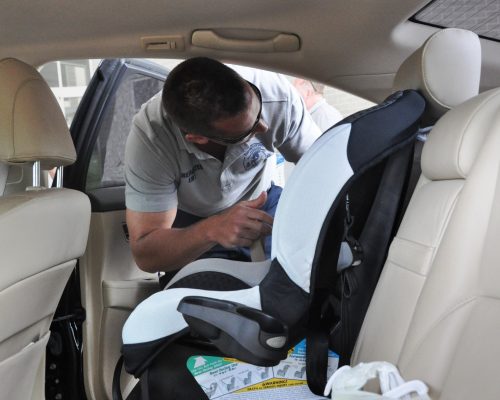
FAQ
Does my vehicle have the LATCH anchors?
If your model year is manufactured after September 1, 2002, then you have the LATCH anchors in your vehicle. These vehicles are required by law to have these anchors placed in at least two places for you to install your child’s car seat. Most designs will have an indicator or marker, such as a dot or a tab, on the seat. There is also a back tether anchor attached to the backside of the seat.
I see the indicator for the LATCH anchor in my vehicle, but I don’t see the anchor. What do I do?
Gently press down on the fabric, where the seat meets the back. You should see the metal anchor protrude from inside the seat. If you still do not see the anchor, consult your owner’s manual to find out how to locate your anchors.
I have a convertible. Why doesn’t my vehicle have the back tether anchor like other cars?
By law, convertibles do not have to have the back tether anchor. They do have to have the seat anchors.
I don’t think I installed my LATCH-equipped car seat correctly. Where can I find some help?
Several locations offer free inspections. These child safety seat checkpoints are often available at your local military base, police department, fire department, hospital, or highway patrol office. The National Highway Traffic Safety Administration has a free tool where you can search for these checkpoints by your state or zip code. Always check that you are receiving assistance from a certified Child Passenger Safety Technician.
Why doesn’t my child’s booster seat have LATCH?
Only some booster seats have LATCH, but many do not. Most booster seats are secured in place by seat belts. If your seat does have LATCH tethers, they attach to the lower anchors in your vehicle. For safety reasons, you may use both the LATCH tethers and the seat belt to secure your child in the booster seat during travel.
I have a vehicle older than the model year 2002. Can I still install a LATCH-equipped car seat?
To use a LATCH car seat, you must have the proper anchors in your vehicle. These anchors became mandatory after 2002. However, you can still install a LATCH car seat with a seat belt. In some cases, you can have a top tether anchor installed in your vehicle for a fee. Unfortunately, it isn’t that common to be able to install lower anchors. You can call your vehicle’s manufacturer or the dealership where you purchased your car for more information on availability and pricing.
How do I know if my LATCH-equipped car seat will fit into my new vehicle?
Shopping for a new car is stressful enough without having to worry if your car seat will fit in the vehicle you want to purchase. When narrowing down your choices for a new car, bring your car seat with you. Ask your sales representative where the LATCH anchors are located and if you can test your car seat inside the vehicle before making your final decision. Most will be happy to let you do so.
I have a rear-facing car seat, but it has a top tether anchor. I thought those only come with forward-facing seats. What should I do?
Depending on the design, some rear-facing car seats do come with a top tether for installation. Refer to your car seat’s instructions for further instruction on how to use the top tether strap during installation.
I see the image describing the weight limits for installing my LATCH car seat. Does that apply to the top tether and anchors or just the lower tethers and anchors?
The labels on LATCH car seats only detail the weight limits for the lower anchors. They do not give information on the weight limits for the top tether or top tether anchors. The user manuals of your car seat and your vehicle will have this information.


